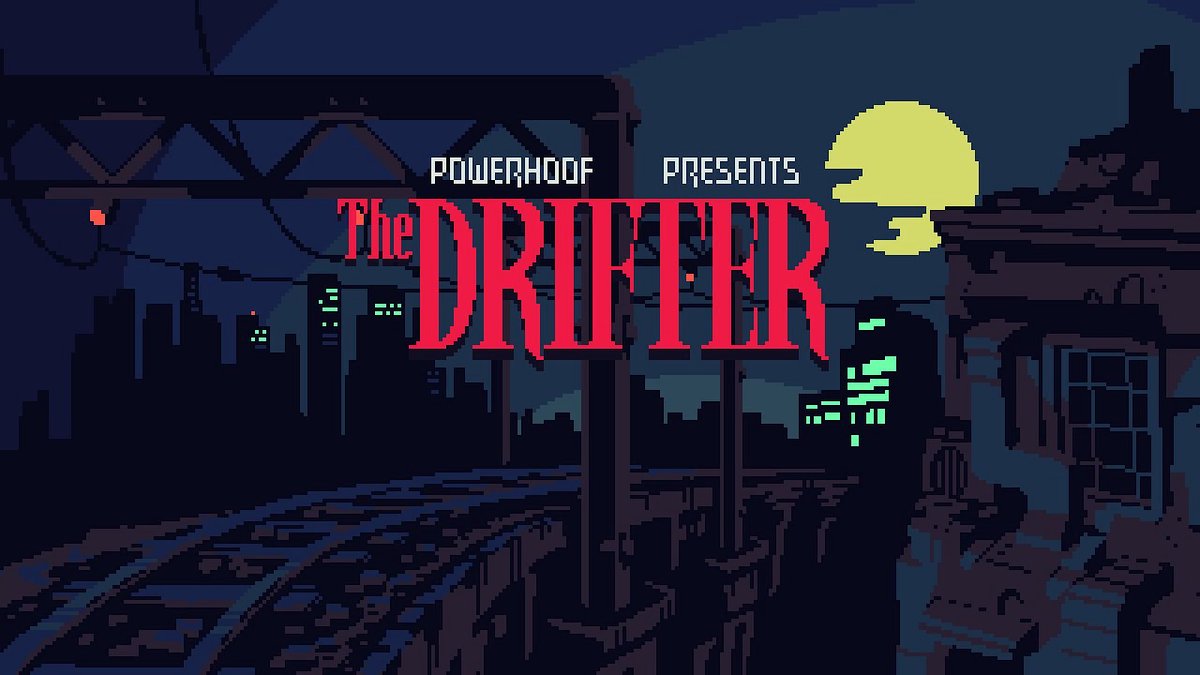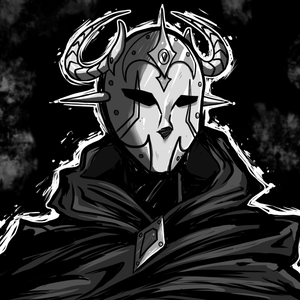In an era where many see the point-and-click adventure as a relic in gaming history, The Drifter proves there is still plenty of life in it. Powerhoof creators David Lloyd and Barney Cumming brought faster pacing to a traditionally slower genre, balancing nostalgia and innovation. It has received overwhelmingly positive reviews on Steam, and the hype keeps on building. I had the chance to speak with David Lloyd about the creation of The Drifter and where he and his team might be heading.
The Drifter started as a game jam project and became an 8-year passion project. Can you walk us through how the scope and vision evolved over time? What were the key turning points?
Yeah, the jam that inspired it was 8 years ago, though we were still busy with other projects then, so it's really more of a 6-year project. The game jam was the first time I'd tried a serious story game. I'd made lots of small point-and-clicks, but they'd always been very silly. We're fans of thrillers and B-grade horror, so I thought I'd give that a go. We made a game called Peridium in a week, and the response was amazing. For a comedy, you might get a chuckle out of a player, but watching Let's Players get really into it and seeing people come up with fan theories in the comments was something I found really rewarding. It felt like it resonated a lot more, so I knew I wanted to follow the same formula with a full-sized game. I naively assumed that scaling a 30-minute game to a 7 hr+ one would just be like doing 14 game jams in a row. But yeah, the complexity goes up exponentially when you don't just have a single plot beat and character arc to hit!
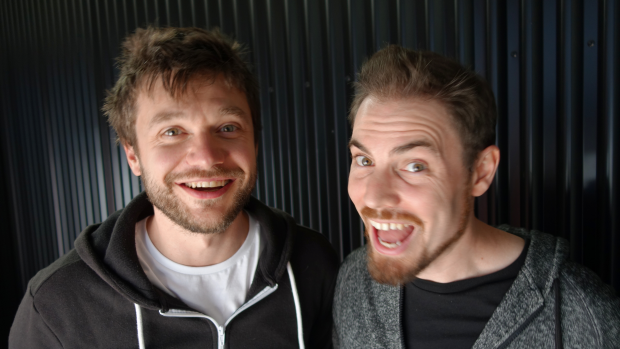
Barry (left) and David (right) of Powerhoof
You've described The Drifter as having "the brake-lines cut" compared to traditional point-and-click adventures. What specific design decisions did you make to modernize the genre while respecting its roots?
Traditionally, people think of point-and-clicks as slow-paced, involving a lot of wandering around randomly mashing objects together, trying to figure out what to do. It felt like a good hook to try and subvert that with a "fast-paced take on a point 'n click," and it was something that worked really well with the game jams we did.
Peridium was a story told in a single room, locked in there, enemies pounding on the door, standing over a dead body. That escalates quickly when you start seeing hallucinations and can't tell what's real... The action of the puzzles flowed from one into the other with an "out of the frying pan, into the fire" thing. In a follow-up jam game, Alluvium, you're stuck on an island, and the puzzles have you fighting back wild dogs with a flaming branch so you can climb a tree to get away, then you're forced to light the tree on fire to signal to a passing ship... so now you're hanging from a burning tree, with rabid dogs biting your heels.
That was the spirit I wanted to bring to The Drifter. It wouldn't have been possible (or fun) to have that continue for the full game, so those become balanced with more open investigative sections, where you get to play detective and try and find some answers. But the puzzles were always intended to be leading the player to something interesting, not trying to get in the way.
I always think it's important to put very specific detail into your game world and writing.
The game has a distinctly Australian flavor, from the setting to the voice acting. How important was it to ground this thriller in Australian culture, and how did that influence the story?
I always think it's important to put very specific detail into your game world and writing. I'm not that experienced as a writer, and so keeping the setting and main characters Aussie meant that I could at least have some idea that they felt "real." I dug a lot into Australian grindhouse movies of the 70s/80s for influence; there was an era there where a lot were being made due to funding that became available at that time. Mad Max was the most famous, but there were a bunch of them, and they had a very rough, gritty vibe that I love.
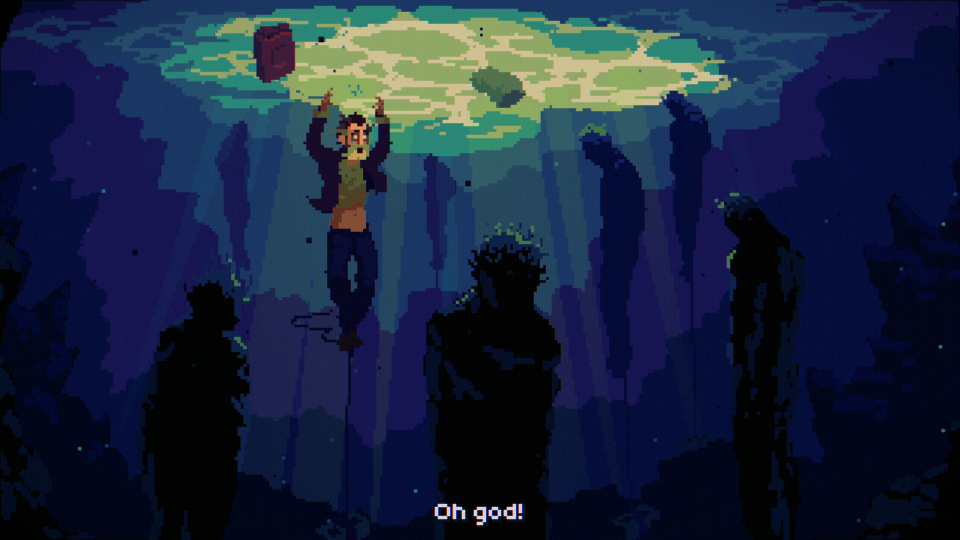
You created PowerQuest specifically for adventure games. How did working on The Drifter inform the development of this tool, and vice versa?
I found I really love working on tools; it's really rewarding. So I had to stop myself from spending too much time adding features to PowerQuest when I was supposed to be solving some difficult design problem on The Drifter! I've used a bunch of tools over the years, though, and I'm really happy with the flexibility that Unity has, but having the point-and-click specific layer over the top to make it super streamlined and easy to do the "adventure game" things. It's also been a real life-saver having a community of people using it to hang out with and chat to during such a long production. I'd have gone crazy if I hadn't had breaks to work on the tools and on other jams during that time.

The twin-stick controller support is unusual for point-and-click games. What inspired this innovation, and how challenging was it to make it feel natural?
I felt like I needed to make sure a bigger project like this would be commercially viable, and one thing that meant was that it wouldn't feel like a PC only game. So controller support was something I knew I needed from the start, and not something that still shows a cursor on screen and just lets you move it around. Something that *felt* like a console game. The challenge is that the mouse cursor is almost an analogue to the main character's thoughts- you move your mouse around the screen just as the main character moves their eyes, and they express to you what they're seeing. So that's very different to the RPG style interaction of walking up to something and "using" it. It's something very specific to point 'n clicks. So yeah, the solution was a radial menu that's from the character's perspective, and lets them still look around and examine or interact with things from afar. It took a bunch of iteration, similar to designing a player controller in a platformer, or combat in a hack 'n slash- there's a lot of nuance into making it feel natural, but I love coding stuff like that. Still, I've been thrilled that people are able to pick it up and figure it out so easily, felt like a huge win!
The game plays exceptionally well on Steam Deck. Was this a deliberate design goal, and how did you approach optimization for handheld play?
I've had the game running on Switch since 2019, long before Steam Deck! It is still yet to ship on Switch, but of course, it works just as well on the Deck. I love how chunky pixel art feels on those smaller screens too!
The synthwave soundtrack and visual style create a distinct mood. How did you collaborate with Mitchell Pasmans on the music to achieve this atmosphere?
Both Mitchell Pasmans, and our early composer Louis Meyer were amazing. The initial inspiration was John Carpenter, starting with the theme from Assault on Precinct 13. Louis was with the project right from the start, and gave the gritty urban setting their vibes. Later when he had a kid and went off to do real-life stuff, Mitchell jumped on, initially for the Lab sequences where he built on the existing music with elements of Vangelis and LucasArt's The Dig. Both of them really got deep into the project, I'd suggest a mood for a section, ramble on about it for a bit, and then they'd come back with something that fit so well, and elevated everything. Was so awesome as a writer to have the music come in and so strongly enhance the tone and vibes of what you're doing.
I adore those communities. There's a lot of angry people on the internet, but I think something about the point 'n click niche attracts very like-minded, chill people.
As a two-person studio, how do you two divide creative responsibilities, especially when you have such different projects (The Drifter vs. Acid Knife)?
The Drifter's kind of been my baby, and Acid Knife's Barney's. For the first 3 years I was solo on Drifter; I basically built it out to be fully playable with just placeholder art while Barney was working on Acid Knife. That way I could get the story solid, test, and iterate without chucking away any final art. Once that was solid, we kicked into full production, and Barney jumped on, along with Matt Frith doing background art and Alexander McDonald doing animation. Barney's still been pottering with Acid Knife in his spare time, but he's keen to jump back into it full time now, I think!
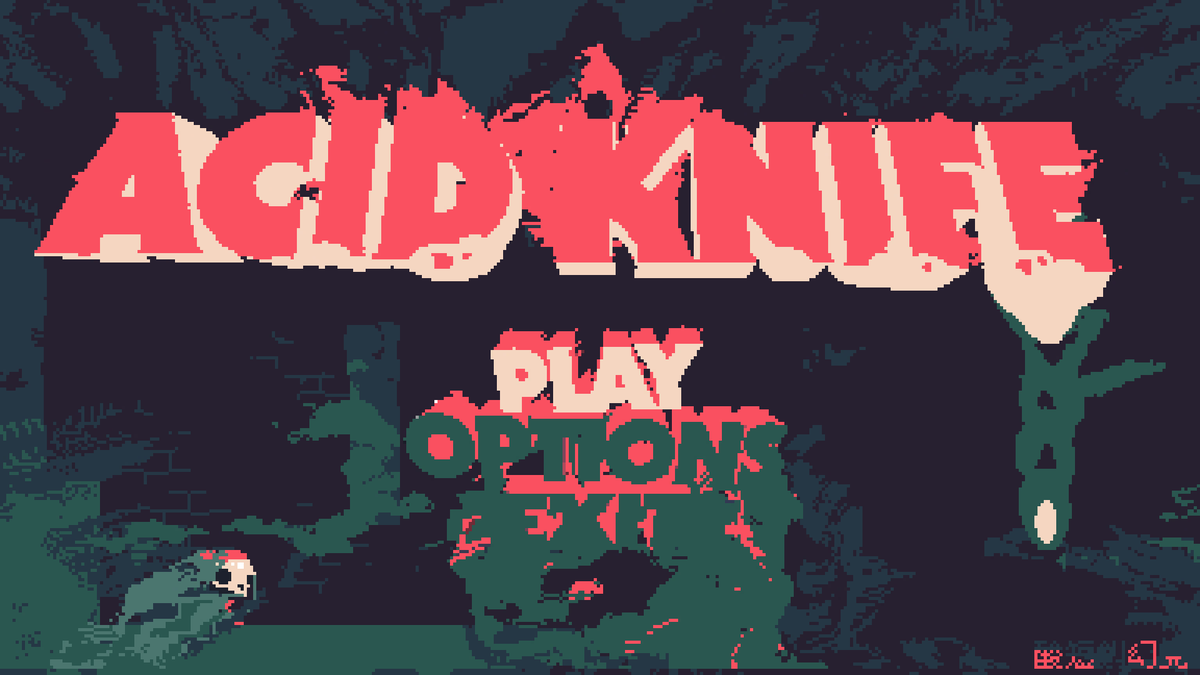
You've been involved with Adventure Jam and the broader adventure game community. How has this community influenced your work?
I adore those communities. There are a lot of angry people on the internet, but I think something about the point-and-click niche attracts very like-minded, chill people. I'm sure there are exceptions, but everyone I've encountered has always been incredibly friendly and supportive. It's partly the nostalgia I had for the adventure game forums I was on in the early 2000s when I first dipped my toe into game dev that made me want to keep making this style of game. If you're making your first game, there's no nicer group to be sharing it with!
The reception's been amazing. Blew my expectations out out of the water, just the sheer quantity alone!
Adrian Vaughan's performance as Mick is particularly strong. How did you direct the voice acting to capture the character's journey?
Adrian and I are old friends, so I didn't have to pull any punches with directing! He was always happy to workshop stuff and spend a while trying to nail a particular section. Plus, he'd always let me know when he'd been out late and would have a particularly gravelly voice the next morning!
Was the woman at the newsstand influenced by Janine (played by Annie Potts) from Ghostbusters?
Well spotted! I had a pic of her in the reference folder I gave to Barney! Other influences for that one included Marsha from Spaced, Kath and Kim, and of course some random people I've known over the years.
The game has received outstanding reviews (98% positive on Steam). Were there any aspects of the critical reception that surprised you?
The reception's been amazing. Blew my expectations out of the water, just the sheer quantity alone! On a personal note, a thing I've found surprising myself was how hard I've found it to read reviews. I feel like I've been doing this long enough to be completely jaded by now, but maybe because it was a long project and I was so close to it, I really struggled to read what people think about it. Maybe just the idea that this thing I worked on is in front of so many people now comes with a kind of cosmic horror I'd forgotten about!
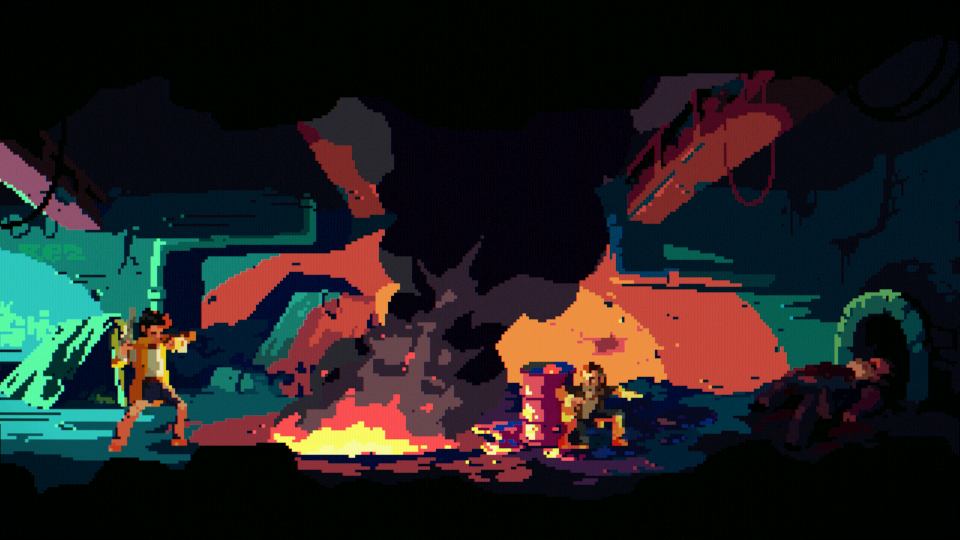
Looking back on this extended development period, what kept you motivated during the longer stretches, and what would you do differently?
I think not knowing how long I had left helped a lot! If I'd known it'd be 6 years when only 2 years in, I might have given up! But doing other little game jams, the tools and community that went along with it really helped too. I've been coming into a shared office and hanging out with other devs, and that's great too. It gets you out of your own head when you can be among people that all have their own game-dev problems to solve!
How has your approach to game development changed from Crawl and Regular Human Basketball to The Drifter?
Hmm, interesting question. On one hand, we're self-funded and able to pay ourselves a salary now, so there's a lot less pressure on that front. But we also have mortgages and kids and grown-up stuff that wasn't a thing 12 years ago when we started. I think we both still just feel like we're working things out as we go, and I'm not sure that'll ever change!
I used to worry that I'd get tired of game dev as I grew older, partly from looking at older devs I used to work with that were pretty burned out and really just turning up for a paycheck. But I'm 43 now, and whenever I do a game jam, I still get fired up about making something new that people get to play. So now I worry more that if every game takes me 6 years, I'll never have time to make all the stuff I want to make!
With The Drifter complete, what's next for Powerhoof? Will you continue in the adventure game space?
Barney'll be jumping back into Acid Knife, and I have some non-adventure game ideas, but yeah, I think I'll always make point-and-clicks. To me, it's a genre in which infinite stories can be told, and I'll always be there for them.
I have three out of four parts of my next game, The Telwynium, out there already for free on itch. I'm looking forward to getting stuck into the final part and then planning to package them all up to put on Steam as well. It's a very chill wind-down project for me to work on after The Drifter. Very nostalgic, with EGA art I'm doing myself and no voice acting, and I'm not trying to modernize the genre here. It's a smaller, quicker, much more niche project, so a lot less pressure, which is just what I need!
You can check out Powerhoof's website here. Be sure to check out their other projects and go out and grab The Drifter on Steam while you are at it.
